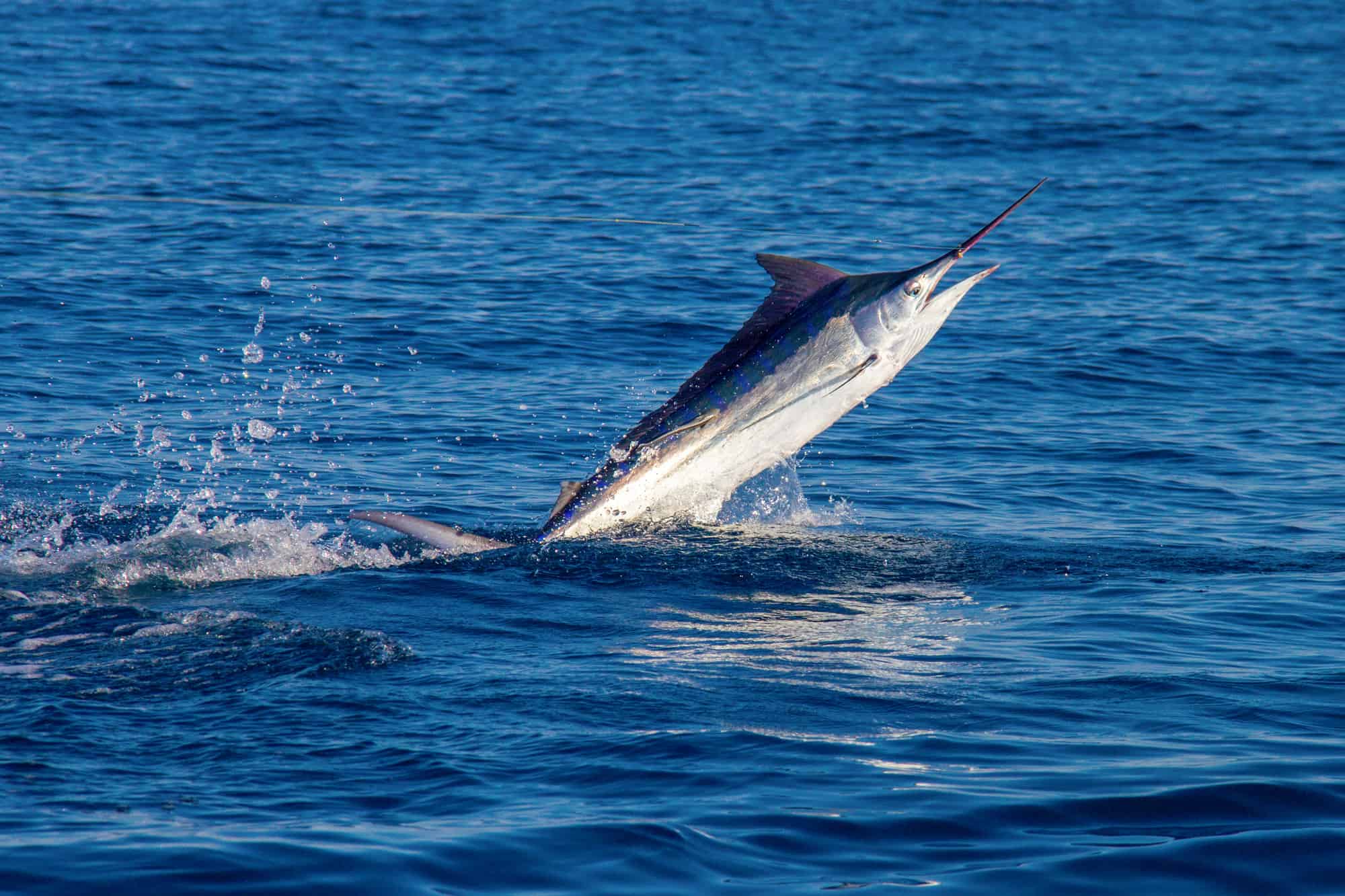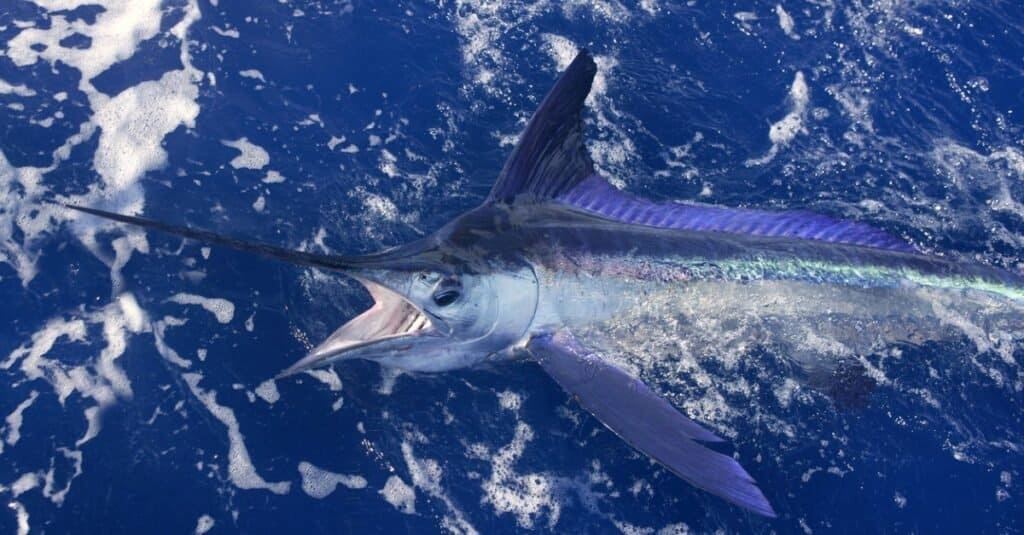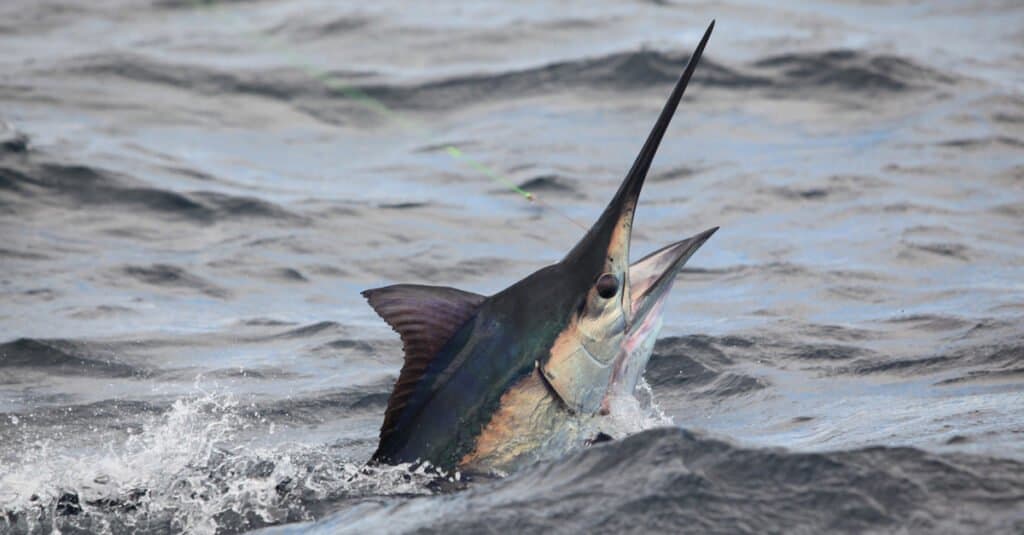
The black marlin is the fastest fish in the world and can swim faster than the incredibly fast
cheetah
can run.
©kelldallfall/Shutterstock.com
In the world of fishing, there are some fish that are thought to be more impressive conquests than others. Catching a marlin is considered to be a huge feat, considering that these fish are not only huge but also move with amazing speed!
There are about 10 species of marlin, and they are all relatively fast and large, although some are more so than others.
However, some people have succeeded in catching these great fish. You might wonder, which of these catches was the largest? Read on to discover the largest marlin ever caught!
Characteristics of the Marlin

Marlins have sword-like upper jaws that they use to snare prey.
©iStock.com/LUNAMARINA
Marlins are fish and part of the family Istiophoridae. These fish have elongated bodies and snouts that strongly resemble spears. They also have long, rigid dorsal fins that form crests in the way that they extend forward. These fish can be found in the Pacific, Atlantic, and Indian Oceans.
The name of the marlin is thought to be based on the resemblance of their faces to the marlinspike of a sailor. They use their sword-like upper jaw to slash and stun their prey, making it easier to catch them. Marlins are closely related to swordfish.
These fish are some of the fastest swimmers in the water. They are able to go up to 68 miles per hour, or 110 kilometers per hour, for short periods of time. They are also a migratory group of fish, traveling hundreds or thousands of miles at a time in warm currents.
The black marlin and the Atlantic blue marlin are the largest species in this group.
Many people see them as popular sporting fish in tropical areas. Due to overfishing, the white marlin and the Atlantic blue marlin are endangered species.
The Largest Marlin Species
It makes sense that the largest marlin ever caught would belong to the largest species, right? So we will take a look at the largest marlin species now!
Black Marlin

The black marlin can weigh more than 1,000 pounds.
©Al McGlashan/Shutterstock.com
Black marlins are not actually black. They are dark blue on top and somewhat whitish on the underside. As is the case with large fish, the female is much larger than the male. Male black marlins usually don’t weigh more than 400 pounds, but the female can be almost 1,000 pounds. Females can be more than 15 feet long, while males are about 9 feet long.
The black marlin (Istiompax indica) reproduces by external fertilization. This means that the female marlin lays millions of eggs, and the males fertilize them later. The juveniles emerge from the eggs and fend for themselves from the very beginning.
The vast majority of these eggs and larvae do not survive, with all of the filter feeders and plankton eaters in the water. Additionally, not every egg is even fertilized, to begin with. These fish prefer warm water. This means they usually inhabit tropical waters and spend a lot of time close to land or coral reefs.
Black marlins are carnivores and predators. They will eat pretty much any fish, although their preference is tuna. They will eat octopuses, cuttlefish, mackerel, trevallies, dolphinfish, squid, and shellfish. The main threat to the black marlin itself is humans and their destructive activities.
Blue Marlin

The blue marlin can grow up to 1,800 pounds.
©Hayk_Shalunts/Shutterstock.com
The blue marlin can grow to weigh more than 1,800 pounds (820 kilograms). It can be more than 16 feet (5 meters) long. This is why it can be surprising that they start out as very tiny larvae, only a few millimeters long.
As is the case with many migratory marine species, females are significantly larger than males. The adult female blue marlin can be about four times the size of the largest male. Like the black marlin, the blue marlin reproduces via external fertilization. The female releases millions of eggs. The hope is that at least one will survive to become an adult blue marlin.
However, they already have a visible bill on their face right after they hatch. Blue marlins can increase their body weight by at least one million times as they grow to adulthood. Because they go from being almost microscopic to being one of the largest predators in the open ocean, they eat a humongous variety of prey throughout their lives.
When they are very young, they eat only minuscule zooplankton. As adults, they eat squids and large bony fish. The size of their prey increases as they grow. However, even the adult blue marlin has predators, mostly large open ocean shark species.
The Largest Marlin Ever Caught

The largest marlin ever caught was a black marlin that weighed 1,560 pounds; it was 14 feet, 6 inches long, and had a girth of 6 feet, 9 inches.
©kelldallfall/Shutterstock.com
The largest marlin ever caught was a black marlin that weighed 1,560 pounds. This fish had a length of 14 feet, 6 inches; its girth was 6 feet, 9 inches. Alfred Gladwell, Jr. caught this Marlin on August 4, 1953. This was the largest marlin that had ever landed on a rod and reel in compliance with rules set forth by the International Game Fish Association.
Glassell used a cero mackerel as bait. He fought with the great fish for about an hour and 45 minutes before making the catch.
Even though on average, the blue marlin is larger than the black marlin, the largest marlin ever caught was a black marlin. The record for the blue marlin was set on February 29, 1992, by Paolo Roberto Amorim when he caught a 1402-pound, 2-ounce Atlantic blue marlin in Vitoria, Brazil. It took him an hour and 20 minutes to catch this fish.
Where to Go to Catch the Marlin
Although the marlin is present in waters all over the world, there are some places where they are more plentiful than others:
- Hawaii – There are likely more blue marlins caught here via rod and reel than anywhere else in the world; the town of Kona is famous all over the world for marlin fishing.
- Mexico – There are many blue and white marlins here from late March all the way through July; even though they tend to be smaller than the ones in the Central Pacific, they tend to be more athletic.
- Australia – Blue and black marlins are frequently caught here; in fact, the Great Barrier Reef is the world’s only confirmed breeding ground for the black marlin.
- The United States East Coast – Whether you want to fish in Florida or off of Delaware, Virginia, or Maryland, there are many white marlins here.
- Central America – Black and blue marlins inhabit these waters throughout the year.
- New Zealand – The main species of marlin here is the striped marlin, although the blue marlin has been caught around here as well.
- Africa‘s West Coast – Cape Verde, 350 miles off of Africa’s coast, is a popular fishing destination and home to many blue and white marlin.
Up Next…
- Lake Monsters! The 10 Biggest Trophy Fish ever Caught in Alabama: There’s good fishing in Alabama – discover the biggest trophy fish ever caught in the state’s beautiful lakes.
- Watch A Mako Shark Leap To Eat a Sailfish, Then Come Back For More: Somehow, this amazing sight was caught on video – check it out!
- World Record Tuna: Discover the Largest Tuna Ever Caught: When you open a can of tuna – you probably don’t think about how big the living fish are. Read about the biggest tuna ever caught!
The photo featured at the top of this post is © iStock.com/LUNAMARINA
Thank you for reading! Have some feedback for us? Contact the AZ Animals editorial team.






